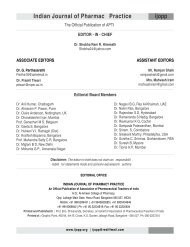Jul-Sep, 2012 - Indian Journal of Pharmacy Practice
Jul-Sep, 2012 - Indian Journal of Pharmacy Practice
Jul-Sep, 2012 - Indian Journal of Pharmacy Practice
You also want an ePaper? Increase the reach of your titles
YUMPU automatically turns print PDFs into web optimized ePapers that Google loves.
Mohammed Saleem TK - Assessment <strong>of</strong> Drug Prescribing Patterns in Dermatology Outpatient Department in a Tertiary Care Hospital, Malabar, Kerala(omnacortil) (Fig7), and efficacies <strong>of</strong> these steroids arepresented in Fig 8, which shows that most <strong>of</strong> the prescriptionscome under high potency steroidal agent. Among the topicalsteroidal agent 91% <strong>of</strong> the patient got high potency steroidalagent (clobetasole). Analysis <strong>of</strong> antifungal group (Fig 9)revealed that out <strong>of</strong> 173 patients requiring an antifungal, 43patients received one topical and one oral antifungal. While14 patients got topical antifungal combination with steroids,20 patients received one topical and one oral and 90 patientsgot only topical antifungal agent, 29 patients received onlysystemic antifungal agents. Fluconazole was most commonlyprescribed because its monthly dose provides cost effectivetreatment and decrease propensity for adverse effect. FromFig 11, it can be seen that antibiotics were prescribed in 287prescriptions out <strong>of</strong> the total 500 patients, among that mostprescribed drug was Roxithromycin. Only 15 patientsreceived antibiotic combination with steroids. Most <strong>of</strong> theantibiotic prescriptions were used in case <strong>of</strong> dermatitis,Eczema, pyoderma condition. Analysis showed that about58.8 % (294 out <strong>of</strong> 500) patients received at least oneantihistamine, the two antihistamines were prescribedtogether on 4 occasions (Fig 10). Present study shows thatvitamins are usually recommended in the case <strong>of</strong>pigmentation disorder like vitiligo, melasma etc and Vit.Acontaining topical agent were used in case <strong>of</strong> acne &ichthyosis. Among astringent category, calamine was themost commonly prescribed products. The miscellaneouscategory included NSAIDS, proton pump inhibitors,analgesic, Antiviral and antiparasitic agent agents (Fig12).study reveals that Fungal infection were the largest group<strong>of</strong> disorder among which T.versicolor was most observedinfection agent. High incidences <strong>of</strong> Dermatitis andhypersensitivity disorder were found in our study, among thatseborrheic dermatitis was most frequently found. About 9.6%<strong>of</strong> patients reported with pigmentation disorder. Incidence <strong>of</strong>viral infection (0.8%), parasitic skin infection (1.6%) wasrelatively low. Among the non infective skin disorder,Eczema emerged as the single largest disorder (10.0%) (Fig14).WHO/INRUD rational drug-use indicatorsWHO prescribing indicators are given in Fig 13, result revealsthat out <strong>of</strong> the total 1230 individual drugs prescribed, 13 (1%)were prescribed by generic names and about 18.78% <strong>of</strong> thedrugs were prescribed from the WHO essential drug list. Atotal <strong>of</strong> 1230 individual drugs were prescribed in 500encounters. Overall, the average number <strong>of</strong> drugs perencounter was 2.46. Analyzing for antibiotic prescriptionshowed that 287 individual antibiotics were prescribed for500 patients. Some patients had received more than oneantibiotic, as a systemic preparation in combination witheither a topical application or another systemic preparation.None <strong>of</strong> the patients received triple antibiotics. Overall, theproportions <strong>of</strong> encounters with at least one antibioticprescribed shows 23.3%. Present study shows that total <strong>of</strong>9.75 % drugs prescribed as fixed drug combination, amongthat only 0.2% accounting as essential one.DISCUSSIONIn the present study, even though the sample size was not verylarge, it gave a cross-section <strong>of</strong> patients and the diseases forwhich they reported for treatment. The disease pr<strong>of</strong>iledescribed in this study corresponds well with the healthstatistics from the <strong>Indian</strong> dermatology department (fungiinfection, dermatitis) accounting for most morbidity reportedfrom the dermatology outpatient department. The number <strong>of</strong>male patients was more than females and the ratio was more. 11than that expected from the sex ratio <strong>of</strong> other studies It isimportant to choose the right medicine(s) for a patient and inan appropriate manner in order to achieve the best results <strong>of</strong>medicine therapy. In our study it is heartening to note thatmore than 90 percentage <strong>of</strong> medicines, recorded route <strong>of</strong>administration, dose, frequency <strong>of</strong> administration andduration <strong>of</strong> treatment. This positive observation would be asign <strong>of</strong> good prescribing patterns in this dermatologyoutpatient department. The irrational use <strong>of</strong> drugs is acommon occurrence throughout the world. Average number<strong>of</strong> drugs per prescription is an important index <strong>of</strong> prescriptionaudit. In our study the mean number <strong>of</strong> drugs per prescriptionwas found to be 2.46, it was lower than what had been12previously reported in other studies in Western Nepal and. 13other parts <strong>of</strong> India It is preferable to keep the number <strong>of</strong>drugs per prescription as low as possible since higher figureslead to increase risk <strong>of</strong> drug interaction, adverse effect andincreased cost to the patient. Our study reports that only 1% <strong>of</strong>drugs were prescribed by generic name. Our value is less than14, 15 .that reported in other studies The decreasing percentage<strong>of</strong> drugs prescribed by generic names in our hospital is amatter <strong>of</strong> concern and the reasons for these should beinvestigated. Prescribing by brand name may be an evidence<strong>of</strong> dangerous promotional strategy by pharma companies.Our study revealed that the percentage <strong>of</strong> drugs prescribedfrom WHO essential drug list was only 20.16%, which islower compare to that <strong>of</strong> the study conducted in North India10(75-95%) . The possible reason for this lower value could bethe prescribers lacking the understanding and importance <strong>of</strong>essential drug concept. The low rate <strong>of</strong> prescribing fromWHO essential drug list may be contributed by excessive use<strong>of</strong> antihistamines (cetrizine), antibiotics (Roxithromycin,fusidic acid) and several topical steroidal preparation whichare not included in WHO essential drug list. In the presentstudy total <strong>of</strong> 9.75% fixed drug combination were prescribed,among that only 0.2% could be considered as essential whichis much lower than what have been previously reported (39%)<strong>Indian</strong> <strong>Journal</strong> <strong>of</strong> <strong>Pharmacy</strong> <strong>Practice</strong> Volume 5 Issue 3 <strong>Jul</strong> - <strong>Sep</strong>, <strong>2012</strong> 64
















